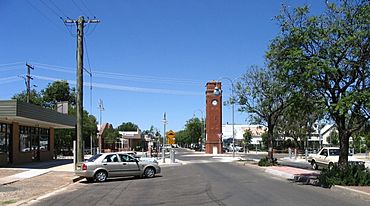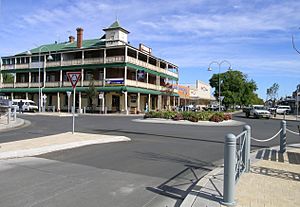Wee Waa facts for kids
Quick facts for kids Wee WaaNew South Wales |
|||||||||||||||
|---|---|---|---|---|---|---|---|---|---|---|---|---|---|---|---|

Main street
|
|||||||||||||||
| Population | 2,034 (2021 census) | ||||||||||||||
| Postcode(s) | 2388 | ||||||||||||||
| Elevation | 190 m (623 ft) | ||||||||||||||
| Location | |||||||||||||||
| LGA(s) | Narrabri Shire | ||||||||||||||
| County | White | ||||||||||||||
| State electorate(s) | Barwon, Tamworth | ||||||||||||||
| Federal Division(s) | Parkes | ||||||||||||||
|
|||||||||||||||
Wee Waa (pronounced wee-wah) is a town in New South Wales, Australia. It is located on the north-western slopes of the New England region. The town is part of the Narrabri Shire area. It sits right on the Namoi River.
Wee Waa is about 41 kilometers (25 miles) north-west of Narrabri. It is also about 571 kilometers (355 miles) north-west of Sydney. You can find it along the Kamilaroi Highway. In 2021, about 2,034 people lived in Wee Waa.
The town is often called the "Cotton Capital of Australia." This is because it's a big center for growing cotton. It's in a very rich farming area called the Lower Namoi Valley. The name "Wee Waa" comes from the Kamilaroi Aboriginal people's language. It means "Fire for Roasting." Wee Waa is also a gateway to other towns like Walgett and Lightning Ridge, which is famous for opals. The town is about 190 meters (623 feet) above sea level.
Contents
History of Wee Waa
Before European settlers arrived, the Gamilaraay/Kamilaroi Aboriginal people lived in the Wee Waa area. In 1837, a settler named George Hobler started a farm here. This led to the town growing.
Wee Waa became an important administrative center in the late 1840s. A police station and a court were set up in 1847. A post office opened two years later. It is the oldest town in this region. Wee Waa is also where the commercial cotton industry in Australia first began.
In 1901, train services were extended to pass through Wee Waa. This connected the town to Narrabri and Walgett. The first commercial cotton farm started here in 1961. It used water from the Keepit Dam on the Namoi River for irrigation.
Wee Waa was the first town built along the Namoi River. The town sometimes experiences floods from the river. A special wall, called a levee bank, helps protect it. However, in February 2012, floods still cut off thousands of people in the surrounding areas.
Environment and Climate
Natural Environment
The Wee Waa area has warm summers. The average low temperature in summer is 20°C (68°F). The average high temperature is 35°C (95°F). Winters are cooler. Temperatures usually range from 4°C (39°F) to 18°C (64°F).
On average, Wee Waa gets about 575 millimeters (22.6 inches) of rain each year. This rain falls on about 80 days. The Namoi River often floods the town and nearby areas. When this happens, supplies sometimes need to be brought in by helicopter.
Town Facilities
Wee Waa has many facilities for its residents and visitors. There are two motels and two hotels. The town also has two caravan parks. For education, there are four schools and a preschool. A new medical center helps keep everyone healthy.
For fun, Wee Waa has a public swimming pool. There is also a nine-hole golf course, a bowling club, and tennis courts. A modern sports complex provides many options for activities. The town also has places to eat and a hostel for older people.
Wee Waa is connected by NSW TrainLink rail services. Interstate buses also stop here. You can also fly to and from Narrabri, which has daily air services.
Notable Events in Wee Waa
| Historical population | ||
|---|---|---|
| Year | Pop. | ±% |
| 1954 | 1,075 | — |
| 1961 | 1,099 | +2.2% |
| 1966 | 1,488 | +35.4% |
| 1971 | 1,845 | +24.0% |
| 1976 | 1,904 | +3.2% |
| 1981 | 1,904 | +0.0% |
| 1986 | 2,106 | +10.6% |
| 1991 | 2,030 | −3.6% |
| 1996 | 1,860 | −8.4% |
| 2001 | 1,814 | −2.5% |
| 2006 | 1,689 | −6.9% |
| 2011 | 1,653 | −2.1% |
| 2016 | 1,632 | −1.3% |
| 2021 | 1,571 | −3.7% |
| Source: Australian Bureau of Statistics data. | ||
In 1973, Arthur Murray led a strike by Aboriginal cotton workers. They wanted better pay and working conditions. This event brought attention to the workers' rights.
A very exciting event happened on May 17, 2013. The famous French music group Daft Punk chose Wee Waa for a special party. They launched their album Random Access Memories at the 79th Annual Wee Waa Show. This brought about 2,500 tourists to the town. Everyone was very excited!
Sports in Wee Waa
Wee Waa has a multi-purpose Sports Complex. It's a central place for many community activities.
Rugby League
The most popular sport in Wee Waa is rugby league. The town's team is called the Wee Waa Panthers. They play in the Group 4 Rugby League competition. This competition is based around Tamworth.
One of the most famous players from the Panthers is Jamie Lyon. He started playing rugby league in Wee Waa. Lyon became a professional player for the Parramatta Eels. But in 2004, he returned to play one season with his home team, the Wee Waa Panthers. That year, the Panthers won the championship against Moree with a score of 55 to 12. Lyon later played for other professional teams. He won championships with the Manly Warringah Sea Eagles in 2008 and 2011.
Soccer
Wee Waa also has a local soccer club. It is called the Wee Waa United Football Club. In 2019, the club won the Namoi Premier League. They beat Narrabri FC 2-1 in extra time. This exciting game was even shown on TV across the state.
Other Sports Achievements
Wee Waa is also home to Andrew Curry. He was an Australian Olympic javelin athlete. Curry was the best javelin thrower in Australia in the 1990s. He competed in two Olympic Games: Atlanta in 1996 and Sydney in 2000. He also competed in three Commonwealth Games.
Wee Waa is known for its large southern blue-tip yabbies. These are a type of freshwater crayfish. On September 4, 1995, Eric Gordon set an Australian record. He caught a yabby that was 47 centimeters (18.5 inches) long!
Notable Residents
- Vincent Ball, an actor born in 1923.
- Braydon Trindall, a professional rugby league player.
See also
 In Spanish: Wee Waa para niños
In Spanish: Wee Waa para niños



